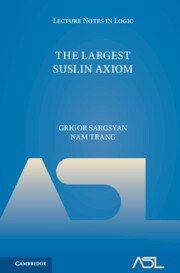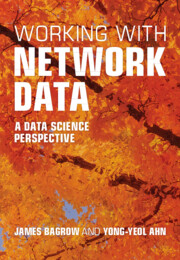Refine search
Actions for selected content:
48558 results in Computer Science
Copyright page
-
- Book:
- Signals, Systems, and Signal Processing
- Published online:
- 29 August 2024
- Print publication:
- 13 June 2024, pp iv-iv
-
- Chapter
- Export citation
References
-
- Book:
- Signals, Systems, and Signal Processing
- Published online:
- 29 August 2024
- Print publication:
- 13 June 2024, pp 685-691
-
- Chapter
- Export citation
Chapter 23 - Statistical models and inference
- from Part III - Fundamentals
-
- Book:
- Working with Network Data
- Published online:
- 06 June 2024
- Print publication:
- 13 June 2024, pp 351-376
-
- Chapter
- Export citation
11 - The Fourier Series
-
- Book:
- Signals, Systems, and Signal Processing
- Published online:
- 29 August 2024
- Print publication:
- 13 June 2024, pp 458-507
-
- Chapter
- Export citation
Summaries and Tables
-
- Book:
- Signals, Systems, and Signal Processing
- Published online:
- 29 August 2024
- Print publication:
- 13 June 2024, pp xxvii-xxviii
-
- Chapter
- Export citation
Part III - Fundamentals
-
- Book:
- Working with Network Data
- Published online:
- 06 June 2024
- Print publication:
- 13 June 2024, pp 315-316
-
- Chapter
- Export citation
3 - Linear Time-Invariant Systems
-
- Book:
- Signals, Systems, and Signal Processing
- Published online:
- 29 August 2024
- Print publication:
- 13 June 2024, pp 62-116
-
- Chapter
- Export citation
15 - More on Bandlimited Signals*
-
- Book:
- Signals, Systems, and Signal Processing
- Published online:
- 29 August 2024
- Print publication:
- 13 June 2024, pp 601-625
-
- Chapter
- Export citation
Chapter 6 - Gathering data
- from Part II - Applications, tools, and tasks
-
- Book:
- Working with Network Data
- Published online:
- 06 June 2024
- Print publication:
- 13 June 2024, pp 73-82
-
- Chapter
- Export citation
Chapter 11 - Explore and explain: statistics for network data
- from Part II - Applications, tools, and tasks
-
- Book:
- Working with Network Data
- Published online:
- 06 June 2024
- Print publication:
- 13 June 2024, pp 137-164
-
- Chapter
- Export citation
11 - The Fourier Series
-
- Book:
- Signals, Systems, and Signal Processing
- Published online:
- 29 August 2024
- Print publication:
- 13 June 2024, pp 458-507
-
- Chapter
- Export citation
Chapter 14 - Summarizing and comparing networks
- from Part II - Applications, tools, and tasks
-
- Book:
- Working with Network Data
- Published online:
- 06 June 2024
- Print publication:
- 13 June 2024, pp 223-234
-
- Chapter
- Export citation
12 - The DFT and the FFT
-
- Book:
- Signals, Systems, and Signal Processing
- Published online:
- 29 August 2024
- Print publication:
- 13 June 2024, pp 508-555
-
- Chapter
- Export citation
Chapter 26 - Embedding and machine learning
- from Part III - Fundamentals
-
- Book:
- Working with Network Data
- Published online:
- 06 June 2024
- Print publication:
- 13 June 2024, pp 429-446
-
- Chapter
- Export citation
Chapter 17 - Research record-keeping
- from Interlude — Good practices for scientific computing
-
- Book:
- Working with Network Data
- Published online:
- 06 June 2024
- Print publication:
- 13 June 2024, pp 283-288
-
- Chapter
- Export citation
Part II - Applications, tools, and tasks
-
- Book:
- Working with Network Data
- Published online:
- 06 June 2024
- Print publication:
- 13 June 2024, pp 63-64
-
- Chapter
- Export citation

The Largest Suslin Axiom
-
- Published online:
- 07 June 2024
- Print publication:
- 27 June 2024

Working with Network Data
- A Data Science Perspective
-
- Published online:
- 06 June 2024
- Print publication:
- 13 June 2024
Design issues concerning circular economy assessment methods at the product level: a comparative analysis through a case study of a mobile tiny house
- Part of
-
- Journal:
- Design Science / Volume 10 / 2024
- Published online by Cambridge University Press:
- 05 June 2024, e12
-
- Article
-
- You have access
- Open access
- HTML
- Export citation
